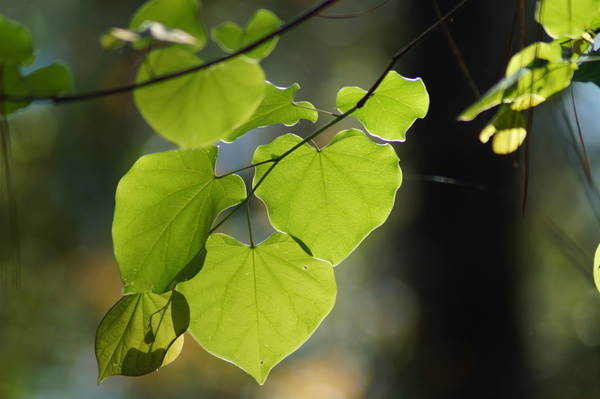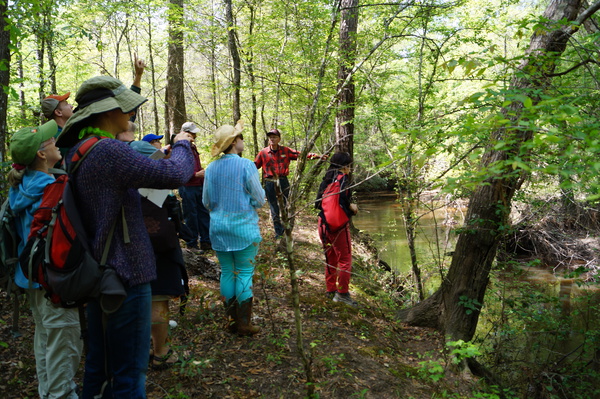Our three car caravan drove through Houston, up U.S. 59, past Kingwood, the habitat destroying Grand Parkway, New Caney, and Shepherd. We exited Fostoria Road, turned under U.S. 59, headed north, turned west on Morgan-Cemetery Road and drove about 3 miles to the yellow gate with the “Tree ID” sign.
Then we wound our way down small 'woods roads”, turned left, and came into the forest opening where the pavilion is located. Tom always gets “uptight” about parking the cars but we followed his orders and soon were removed our packs and seated ourselves under the shaded roof. Several more people arrived a few minutes later and I counted heads. We had 11 eager students who wanted to learn how to identify some of the most common trees in East Texas.
and soon were removed our packs and seated ourselves under the shaded roof. Several more people arrived a few minutes later and I counted heads. We had 11 eager students who wanted to learn how to identify some of the most common trees in East Texas.
I collected the fee for this “fun-raiser” for the Houston Sierra Club, handed out the “Tree ID” materials, and we were ready to go. Tom sat to my left and behind me and everyone else was in front of me. We talked briefly about forests and forest ecology and then discussed some basics about tree identification.
Our presentation was simple and brief and within 30 minutes we were off on our morning “Tree ID” walk. Peach Creek Woods, what Tom calls his 128 acres that fronts Peach Creek as it makes its way to Lake Houston, is a diverse and fascinating place to visit. A lot of changes have come to Peach Tree Woods in the past 24 years that Tom has owned this piece of East Texas forest. Two hurricanes, a record drought, several windstorms, ice storms, hail storms, and heavy rains and floods have all affected Peach Creek Woods. Although a lot of trees have died this forest is still diverse and beautiful to walk through.
We started down a “woods road” and stopped periodically to test the new “Tree ID” skills of our participants that were in the making. Red Bay, Yaupon Holly, Eastern Hop Hornbeam, American Hornbeam, Devil's Walking Stick, Carolina Cherry Laurel, Laurel Oak, the names flew off Tom's and my tongues as we pointed out certain characteristics that would help with identification.
Are the leaves opposite or alternate; compound or simple; toothed or smooth; have lobes and sinuses; dark or light green? Is the bark rough or smooth?
We then turned off the “woods road” and descended down-slope, away from the sandy uplands toward Peach Creek. As we sloped down it became evident that water did the same. We came upon seepage areas with Royal and Netted Chain Ferms, Red Maple, Southern Magnolia, Sweetbay Magnolia, Black Gum, and Swamp Chestnut Oak. The upland pine soils are porous and permeable and rainwater percolates down until it hits a hard, impermeable, clay layer (called a aquaclude or aquatard), and then flows horizontally until it seeps out at the bottom of the slope.
Then we stood on the bank of Peach Creek, a beautiful tannin-stained stream that meanders back and forth across its floodplain. The River Birches stood like sentinels on the banks and Tom pointed out a Water Elm in a swale next to the creek. Beavers had chewed off the bark of a Sweetgum and Black Gum that stood side-by-side. Tom curses beavers because of their hunger but I always think it is a thrill to know that they are somewhere nearby.
We made our way back out of the floodplain, up the hill, and had lunch at the pavilion. People looked at the 10 or so “Tree ID” field guides I brought. I told everyone that it was personal preference whether you like illustrations or photos and the important thing was to use a field guide that you felt comfortable with. I also suggested that a pair of binoculars and a magnifying lens would be helpful so that you could see leaves 50 to 100 feet up in the canopy and very small identification marks on leaves or other tree parts.
Then we were off for our afternoon stroll. The morning had been just perfect with a small breeze. The afternoon was warmer and told us that summer was not far away. Tom went with part of the way and showed us the Longleaf Pine he had planted over 20 years ago. For the first time Tom had huge foot-long pine cones on this tree and he was delighted to show them off to us as well as the foot-long needles.
Then Tom went back to the pavilion to rest and we continued. We saw Sassafras, Black Cherry, Red Bud, an almost four foot diameter Southern Magnolia, more seepage areas, white violets, Sweetbay Magnolia, White Oak, Bitternut Hickory, Bald Cypress, and much, much more.
By the time we got back to the pavilion it was after 3 pm and we took a short quiz (hint: no one failed). Now it was time for us to go home. We all said our goodbyes, reformed the caravan, and tooled back to Houston, tired but happy with the great day and beautiful scenery.
“Tree ID” is a special event. I hope you will join us next time.
Brandt Mannchen
March 27, 2016

